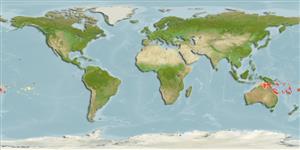>
Eupercaria/misc (Various families in series Eupercaria) >
Labridae (Wrasses)
Etymology: Labropsis: Greek, labrax, -akos = a fish, Dicentrarchus labrax + Greek,opsis = appearance (Ref. 45335).
More on author: Randall.
Environment: milieu / climate zone / depth range / distribution range
Ökologie
seewasser riff-verbunden; tiefenbereich 2 - 55 m (Ref. 2334). Tropical; 9°S - 24°S (Ref. 2137)
Western Pacific: Solomon Islands, American Samoa, Vanuatu, Fiji, Loyalty Islands in New Caledonia, Tonga and Great Barrier Reef.
Size / Gewicht / Alter
Maturity: Lm ? range ? - ? cm
Max length : 10.5 cm TL Männchen/unbestimmt; (Ref. 2334)
Rückenflossenstacheln (insgesamt): 9; Rückenflossenweichstrahlen (insgesamt): 12; Afterflossenstacheln 3; Afterflossenweichstrahlen: 11
Inhabits shallow reef areas with high coral cover (Ref. 9823). Adults feed on coral polyps while juveniles take ectoparasites and possibly mucus of other reef fishes (Ref. 9823).
Life cycle and mating behavior
Geschlechtsreife | Fortpflanzung | Ablaichen | Eier | Fecundity | Larven
Oviparous, distinct pairing during breeding (Ref. 205).
Randall, J.E., G.R. Allen and R.C. Steene, 1990. Fishes of the Great Barrier Reef and Coral Sea. University of Hawaii Press, Honolulu, Hawaii. 506 p. (Ref. 2334)
IUCN Rote Liste Status (Ref. 130435)
Bedrohung für Menschen
Harmless
Nutzung durch Menschen
Mehr Information
ReferenzenAquakulturAquakultur ProfilZuchtlinienGenetikElectrophoresesVererbbarkeitKrankheitenVerarbeitungNutrientsMass conversion
PartnerBilderStamps, Coins Misc.LauteCiguateraGeschwindigkeitSchwimmstilKiemenoberflächeOtolithsGehirngrößeSehfähigkeit
Tools
Zusatzinformationen
Download XML
Internet Quellen
Estimates based on models
Preferred temperature (Ref.
123201): 24.9 - 28, mean 26.8 °C (based on 124 cells).
Phylogenetic diversity index (Ref.
82804): PD
50 = 0.5156 [Uniqueness, from 0.5 = low to 2.0 = high].
Bayesian length-weight: a=0.00955 (0.00456 - 0.02002), b=3.06 (2.89 - 3.23), in cm total length, based on LWR estimates for this (Sub)family-body shape (Ref.
93245).
Trophic level (Ref.
69278): 3.9 ±0.61 se; based on food items.
Widerstandsfähigkeit (Ref.
120179): hoch, Verdopplung der Population dauert weniger als 15 Monate. (Preliminary K or Fecundity.).
Fishing Vulnerability (Ref.
59153): Low vulnerability (10 of 100).
Nutrients (Ref.
124155): Calcium = 103 [61, 190] mg/100g; Iron = 0.797 [0.451, 1.508] mg/100g; Protein = 18.6 [15.7, 20.8] %; Omega3 = 0.188 [0.113, 0.312] g/100g; Selenium = 25.1 [13.6, 47.4] μg/100g; VitaminA = 166 [49, 671] μg/100g; Zinc = 1.73 [1.14, 2.67] mg/100g (wet weight);
